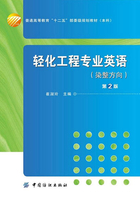
Lesson 7 Emulsification by Surfactants
7.1 Emulsion
An emulsion is a mixture of two immiscible (unblendable) substances. One substance (the dispersed phase) is dispersed in the other (the continuous phase). Emulsification is the process by which emulsions are prepared. It is probably the most versatile of surface active agents for practical applications and,as a result,has been extensively studied.
Two immiscible,pure liquids cannot form an emulsion. For a suspension of one liquid in another to be stable enough to be classified as an emulsion,a third component must be present to stabilize the system.① The third component is called the emulsifying agent which is usually a surfactant.
Macroemulsions are of two types,based on the nature of the dispersed phase,oil-in-water (O/W) and water-in-oil (W/O). The oil-in-water type is a dispersion of a water-immiscible liquid or solution,always called the oil (O),regardless of its nature,in an aqueous phase (W). The oil is,in this case,the discontinuous(inner) phase; the aqueous phase is the continuous(outer) phase. The water-in-oil type is a dispersion of water or an aqueous solution (W) in a water-immiscible liquid (O). The type of emulsion formed by the water and the oil depends primarily on the nature of the emulsifying agent,to a minor extent,on the process used in preparing the emulsion and the relative proportions of oil and water present.② In general,O/W emulsions are produced by emulsifying agents that are more soluble in the water than in the oil phase,whereas W/O emulsions are produced by emulsifying agents that are more soluble in the oil than in the water.
These two types of emulsions are easily distinguished:(1) An emulsion can readily be diluted with more of the outer phase,but not as easily with the inner phase. Consequently O/W emulsions disperse readily in water; W/O do not,but they do disperse readily in oil. This method works best on dilute emulsions.(2) O/W emulsions have electrical conductivities similar to that of the water phase; W/O emulsions do not conduct current significantly.(3) W/O emulsions will be colored by oil-soluble dyes,whereas O/W emulsions show the color faintly,if at all,but will be colored by water-soluble dyes.
(4) If the two phases have different refractive indices,microscopic examination of the droplets will determine their nature. A droplet,on focusing upward,will appear brighter if its refractive index is greater than the continuous phase and darker if its refractive index is less than that of the continuous phase. This clearly identifies the substance in the droplet,if one knows the relative refractive indices of the two phases.
(5) In filter paper tests,a drop of an O/W emulsion produces an immediate wide moist area; a drop of W/O emulsion does not. If the filter paper is first impregnated with a 20% cobaltous chloride solution and dried before the test,the area around the drop immediately turns pink if the emulsion is O/W and remains blue (shows no color change) if it is W/O.
Emulsions are significantly stable. The significantly stable means relative to the intended use and may range from a few minutes to a few years.
The rate at which the droplets of a macroemulsion coalesce to form larger droplets and eventually breakthe emulsion has been found to depend on a number of factors: the physical nature of the interfacial film; the existence of an electrical or steric barrier on the droplets; the viscosity of the continuous phase; the size distribution of the droplets; the phase volume ratio;the temperature.